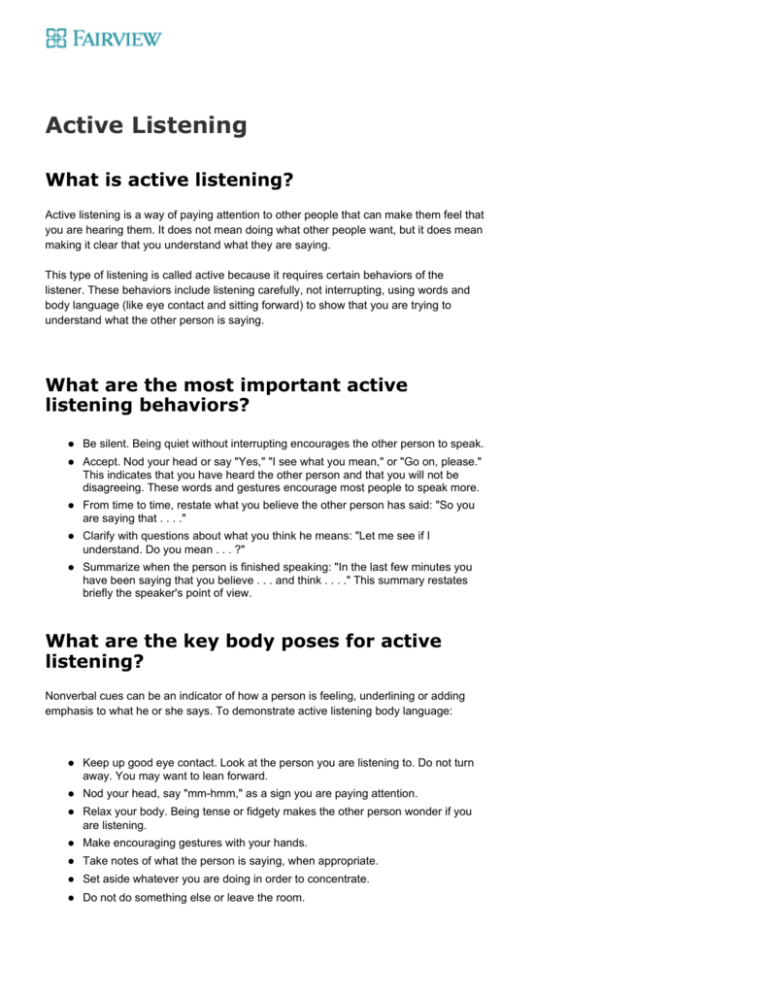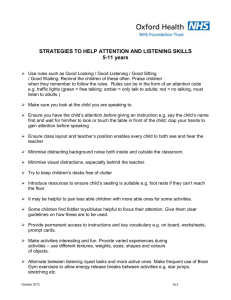
Active Listening
What is active listening?
Active listening is a way of paying attention to other people that can make them feel that
you are hearing them. It does not mean doing what other people want, but it does mean
making it clear that you understand what they are saying.
This type of listening is called active because it requires certain behaviors of the
listener. These behaviors include listening carefully, not interrupting, using words and
body language (like eye contact and sitting forward) to show that you are trying to
understand what the other person is saying.
What are the most important active
listening behaviors?
z
Be silent. Being quiet without interrupting encourages the other person to speak.
z
Accept. Nod your head or say "Yes," "I see what you mean," or "Go on, please."
This indicates that you have heard the other person and that you will not be
disagreeing. These words and gestures encourage most people to speak more.
z
From time to time, restate what you believe the other person has said: "So you
are saying that . . . ."
z
Clarify with questions about what you think he means: "Let me see if I
understand. Do you mean . . . ?"
z
Summarize when the person is finished speaking: "In the last few minutes you
have been saying that you believe . . . and think . . . ." This summary restates
briefly the speaker's point of view.
What are the key body poses for active
listening?
Nonverbal cues can be an indicator of how a person is feeling, underlining or adding
emphasis to what he or she says. To demonstrate active listening body language:
z
Keep up good eye contact. Look at the person you are listening to. Do not turn
away. You may want to lean forward.
z
Nod your head, say "mm-hmm," as a sign you are paying attention.
z
Relax your body. Being tense or fidgety makes the other person wonder if you
are listening.
z
Make encouraging gestures with your hands.
z
Take notes of what the person is saying, when appropriate.
z
Set aside whatever you are doing in order to concentrate.
z
Do not do something else or leave the room.
Why is active listening difficult?
A number of feelings and circumstances can get in the way of active listening and make
it difficult:
z
When people are preoccupied with current life stresses or difficult situations, it is
hard for them to listen.
z
Anxiety can make it hard to listen. For example, children who are anxious at
school often have difficulty learning.
z
Being angry at the person who is talking also makes it hard to listen, especially if
the person is blaming you or talking about something he or she feels is your
fault.
z
Having an idea in mind of what a person "should" do makes it hard to listen to
that person's point of view. This is particularly true if the feelings he or she is
expressing do not seem logical to you.
What behaviors should be avoided in
active listening?
z
Avoid "why" questions. These tend to make people feel defensive.
z
Do not tell the other person what to do.
z
Avoid quick reassurance, saying things like, "Don't worry about that."
z
Avoid rejecting, making fun of the other person, or refusing to listen to the
person about something.
z
Avoid digging for information and forcing the other person to talk about
something he or she would rather not talk about.
Why is active listening important?
Active listening is important because it can help you understand other people. This can
make you more successful in the workplace and help you have better relationships with
friends and family. When other people feel you really listen to them, they can be much
easier to deal with because they feel you understand their position.
Written by Lee Scheingold, MSW.
Published by RelayHealth.
Last modified: 2008-08-11
Last reviewed: 2008-02-14
This content is reviewed periodically and is subject to change as new
health information becomes available. The information is intended to
inform and educate and is not a replacement for medical evaluation,
advice, diagnosis or treatment by a healthcare professional.
Behavioral Health Advisor 2009.1 Adult Topics Index
Behavioral Health Advisor 2009.1 Credits
© 2009 RelayHealth and/or its affiliates. All Rights Reserved.







